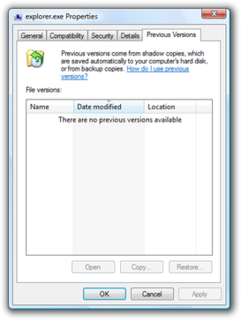
Microsoft Access is a database management system (DBMS) from Microsoft that combines the relational Microsoft Jet Database Engine with a graphical user interface and software-development tools. It is a member of the Microsoft 365 suite of applications, included in the Professional and higher editions or sold separately.
Object Linking & Embedding (OLE) is a proprietary technology developed by Microsoft that allows embedding and linking to documents and other objects. For developers, it brought OLE Control Extension (OCX), a way to develop and use custom user interface elements. On a technical level, an OLE object is any object that implements the IOleObject interface, possibly along with a wide range of other interfaces, depending on the object's needs.
A patch is a set of changes to a computer program or its supporting data designed to update, fix, or improve it. This includes fixing security vulnerabilities and other bugs, with such patches usually being called bugfixes or bug fixes. Patches are often written to improve the functionality, usability, or performance of a program.

Microsoft Project is a project management software product, developed and sold by Microsoft. It is designed to assist a project manager in developing a schedule, assigning resources to tasks, tracking progress, managing the budget, and analyzing workloads.

In computing, XCOPY is a command used on IBM PC DOS, MS-DOS, IBM OS/2, Microsoft Windows, FreeDOS, ReactOS, and related operating systems for copying multiple files or entire directory trees from one directory to another and for copying files across a network.

Shadow Copy is a technology included in Microsoft Windows that can create backup copies or snapshots of computer files or volumes, even when they are in use. It is implemented as a Windows service called the Volume Shadow Copy service. A software VSS provider service is also included as part of Windows to be used by Windows applications. Shadow Copy technology requires either the Windows NTFS or ReFS filesystems in order to create and store shadow copies. Shadow Copies can be created on local and external volumes by any Windows component that uses this technology, such as when creating a scheduled Windows Backup or automatic System Restore point.

Data Transformation Services, or DTS, is a set of objects and utilities to allow the automation of extract, transform and load operations to or from a database. The objects are DTS packages and their components, and the utilities are called DTS tools. DTS was included with earlier versions of Microsoft SQL Server, and was almost always used with SQL Server databases, although it could be used independently with other databases.
Microsoft Servers is a brand that encompasses Microsoft's server products. This includes the Windows Server editions of the Microsoft Windows operating system itself, as well as products targeted at the wider business market. Unlike Microsoft Dynamics or Microsoft Office product lines, most of the products sold under this brand are not intended to be line-of-business services in and of themselves.
Microsoft BizTalk Server is an inter-organizational middleware system (IOMS) that automates business processes through the use of adapters which are tailored to communicate with different software systems used in an enterprise. Created by Microsoft, it provides enterprise application integration, business process automation, business-to-business communication, message broker and business activity monitoring.
Microsoft Visual SourceSafe (VSS) is a discontinued source control program oriented towards small software development projects. Like most source control systems, SourceSafe creates a virtual library of computer files. While most commonly used for source code, SourceSafe can handle any type of file in its database, but older versions were shown to be unstable when used to store large amounts of non-textual data, such as images and compiled executables.
SQL Server Integration Services (SSIS) is a component of the Microsoft SQL Server database software that can be used to perform a broad range of data migration tasks.
SQL Server Reporting Services (SSRS) is a server-based report generating software system from Microsoft. It is part of a suite of Microsoft SQL Server services, including SSAS and SSIS.
Robocopy, for "Robust File Copy", is a command-line directory and/or file replication command for Microsoft Windows. Robocopy functionally replaces Xcopy, with more options. Created by Kevin Allen and first released as part of the Windows NT 4.0 Resource Kit, it has been a standard feature of Windows since Windows Vista and Windows Server 2008. The command is robocopy.
Microsoft Sync Framework is a data synchronization platform from Microsoft that can be used to synchronize data across multiple data stores. Sync Framework includes a transport-agnostic architecture, into which data store-specific synchronization providers, modelled on the ADO.NET data provider API, can be plugged in. Sync Framework can be used for offline access to data, by working against a cached set of data and submitting the changes to a master database in a batch, as well as to synchronize changes to a data source across all consumers and peer-to-peer synchronization of multiple data sources. Sync Framework features built-in capabilities for conflict detection – whether data to be changed has already been updated – and can flag them for manual inspection or use defined policies to try to resolve the conflict. Sync Services includes an embedded SQL Server Compact database to store metadata about the synchronization relationships as well as about each sync attempt. The Sync Framework API is surfaced both in managed code, for use with .NET Framework applications, as well as unmanaged code, for use with COM applications. It was scheduled to ship with Visual Studio 2008 in late November 2007.
Windows Deployment Services is a server technology from Microsoft for network-based installation of Windows operating systems. It is the successor to Remote Installation Services. WDS is intended to be used for remotely deploying Windows Vista, Windows 7, Windows 8, Windows 10, Windows Server 2008, Windows Server 2012 and Windows Server 2016, but also supports other operating systems because unlike its predecessor RIS, which was a method of automating the installation process, WDS uses disk imaging, in particular the Windows Imaging Format (WIM). WDS is included as a Server Role in all 32-bit and 64-bit versions of Windows Server 2008, and is included as an optionally installable component with Windows Server 2003 Service Pack 2.

SharePoint is a web-based collaborative platform that integrates with Microsoft Office. Launched in 2001, SharePoint is primarily sold as a document management and storage system, but the product is highly configurable and its usage varies substantially among organizations.

Microsoft Visual Studio is an integrated development environment (IDE) from Microsoft. It is used to develop computer programs, as well as websites, web apps, web services and mobile apps. Visual Studio uses Microsoft software development platforms such as Windows API, Windows Forms, Windows Presentation Foundation, Windows Store and Microsoft Silverlight. It can produce both native code and managed code.
Microsoft SQL Server is a relational database management system developed by Microsoft. As a database server, it is a software product with the primary function of storing and retrieving data as requested by other software applications—which may run either on the same computer or on another computer across a network. Microsoft markets at least a dozen different editions of Microsoft SQL Server, aimed at different audiences and for workloads ranging from small single-machine applications to large Internet-facing applications with many concurrent users.

This article refers to the last FarPoint Edition of the Spread Product line. Spread is now developed by GrapeCity, Inc. Since the acquisition, Spread for Biztalk Server has been removed from the product line and SpreadJS, a JavaScript version, has been added.







